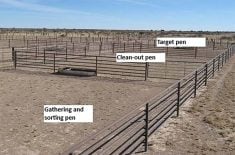Selenium was a key focus in equine nutrition during the 1980s and 1990s.
Since then, attention has shifted toward modern feeding strategies such as low-starch, high-fat diets, magnesium and copper-zinc balance, omega-3s, digestive support with probiotics and prebiotics, and even newer additions such as CBD and medicinal mushrooms.
Despite this shift in focus, selenium has never lost its relevance.
Read Also

Pork sector targets sustainability
Manitoba Pork has a new guiding document, entitled Building a Sustainable Future, outlining its sustainability goals for the years to come.
It is an essential trace mineral that supports antioxidant defense, muscle integrity, immune function, metabolism and thyroid activity.
At the cellular level, it acts as a biochemical bodyguard.
Energy production generates reactive oxygen species (ROS), which are unstable molecules that can damage cells.
Glutathione peroxidase (GPx), a selenium-dependent enzyme, neutralizes ROS.
Without enough selenium, this detox system falters, allowing oxidative stress and tissue damage to build.
This protective role is especially vital in athletic or stressed horses, where selenium deficiency may lead to muscle soreness, poor recovery or tying-up (exertional rhabdomyolysis).
Selenium works closely with vitamin E to strengthen immune health.
White blood cells use oxidative bursts to kill pathogens, but they must simultaneously protect themselves from the very damage they unleash.
Together, selenium and vitamin E help stabilize cell membranes, bolster antibody production and reduce collateral tissue damage.
Horses with marginal selenium levels often exhibit increased susceptibility to respiratory infections, slow wound healing and poor recovery from stressors such as travel or illness.
Less widely known, but equally important, is selenium’s role in endocrine and reproductive health.
Selenium-dependent enzymes convert the thyroid hormone T4 into its active form, T3.
Without sufficient selenium, metabolism lags, even in the presence of adequate iodine.
In broodmares, selenium is essential for fertility and foal health. A selenium-deficient mare is more prone to early embryonic loss, poor colostrum or milk quality, retained placenta and complications post-foaling.
Foals born to selenium-deficient mares are at risk of ”white muscle disease,” a potentially fatal condition characterized by poor suckling ability, muscular weakness and ill-thrift.
Selenium status in the horse ultimately depends on the selenium status of the soil.
In North America, much of the Pacific Northwest, including regions of Alberta, are considered selenium-deficient, especially where grey wooded or acidic soils are common.
Horses grazing or eating hay from these regions may consume as little as 0.05 milligrams of selenium per kilogram of dry matter, just a quarter of their required daily intake.
Even horses outside these areas may be affected because of the widespread distribution of hay from deficient zones.
Many assume commercial feed fills this gap, but ”complete” rations often contain as little as 0.3 mg Se/kg feed and would be sufficient only if the horse consumes the full recommended volume and the hay is not deficient.
Selenium also poses a challenge because of its narrow therapeutic range.
The recommended intake for a 500 kg horse is around one mg per day (0.1–0.2 mg/kg diet dry matter), while intakes above five mg/day sustained over time can become toxic.
Clinical signs of toxicity include brittle, cracked hooves, hair loss (especially in the mane and tail) and in severe cases, neurologic signs such as stumbling or lethargy.
The narrow margin between adequacy and toxicity makes blind supplementation risky and reinforces the need for targeted testing and informed decision-making.
Testing forage for selenium content is valuable but often overlooked.
Standard forage analysis typically includes protein, fibre and major minerals such as calcium and phosphorus. However, trace minerals such as selenium are excluded unless specifically requested.
Selenium testing usually incurs an additional cost and requires specialized methods. Still, it offers vital information, especially in regions known for selenium-deficient soils.
Forage results are reported in parts per million (p.p.m.). Levels below 0.1 p.p.m. are considered clearly deficient, 0.1–0.2 p.p.m. marginal and 0.3 p.p.m. adequate for idle horses. Values nearing two p.p.m. are potentially toxic.
When forage testing isn’t feasible, serum selenium and whole-blood glutathione peroxidase activity are both informative. Whether through hay analysis or blood work, monitoring helps avoid deficiency or toxicity.
Not all supplements are equal.
Organic forms of selenium such as selenium yeast or selenomethionine are better absorbed and retained than inorganic forms such as sodium selenite.
Selenium and vitamin E are closely linked, and optimal antioxidant function depends on adequate natural vitamin E intake (typically 1,000–2,000 IU/day of d-alpha-tocopherol).
Total selenium intake should account for forage, feed, balancers and mineral salts. While idle horses may meet their needs with one mg/day, broodmares and performance horses often require two to three mg/day to maintain optimal health.
In selenium-deficient zones, the first step is to test forage. If selenium levels are low, supplement with an equine-specific mineral mix containing appropriate amounts, ideally from organic sources.
Watch for signs of deficiency — dull coat, muscle weakness, slow exercise recovery, poor fertility, retained placentas, early embryonic loss, or white muscle disease in foals. Collaborate with a veterinarian to interpret results and design a safe, effective supplementation plan.
Amid shifting nutritional trends, selenium remains a cornerstone of muscle strength, immune resilience, thyroid function and reproductive health. When tested wisely and supplemented carefully, it supports horses at every life stage. Small in dose, its impact is immense.

















